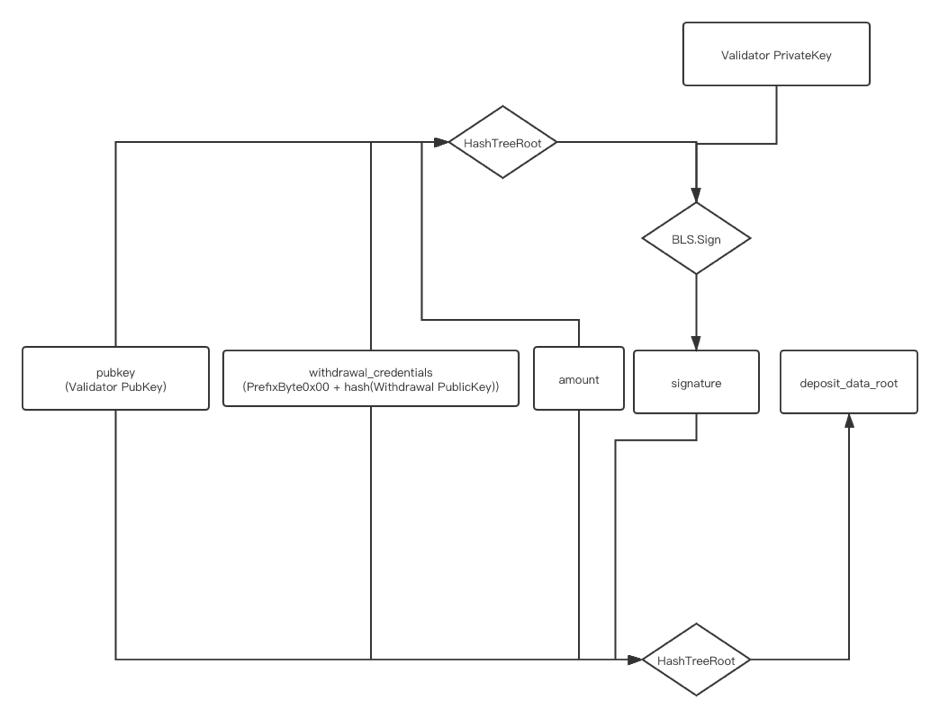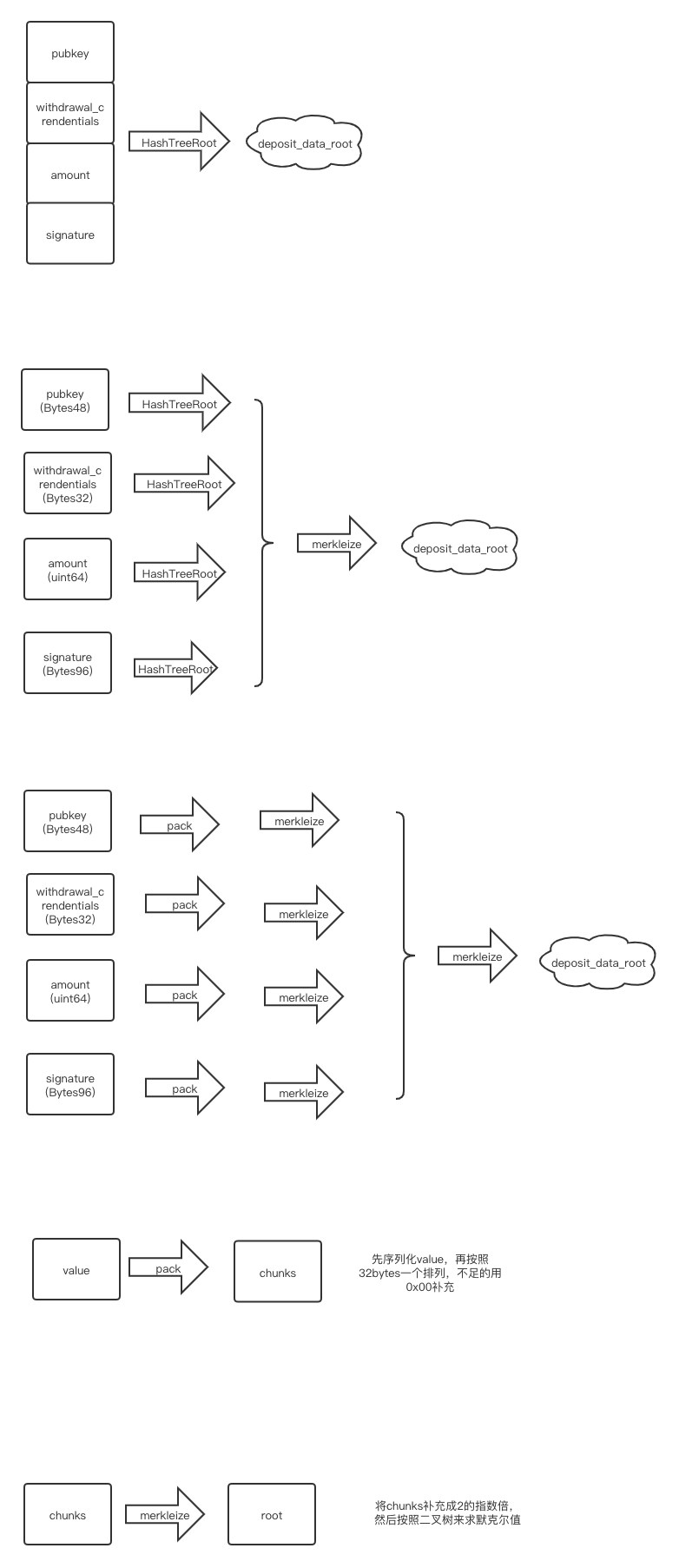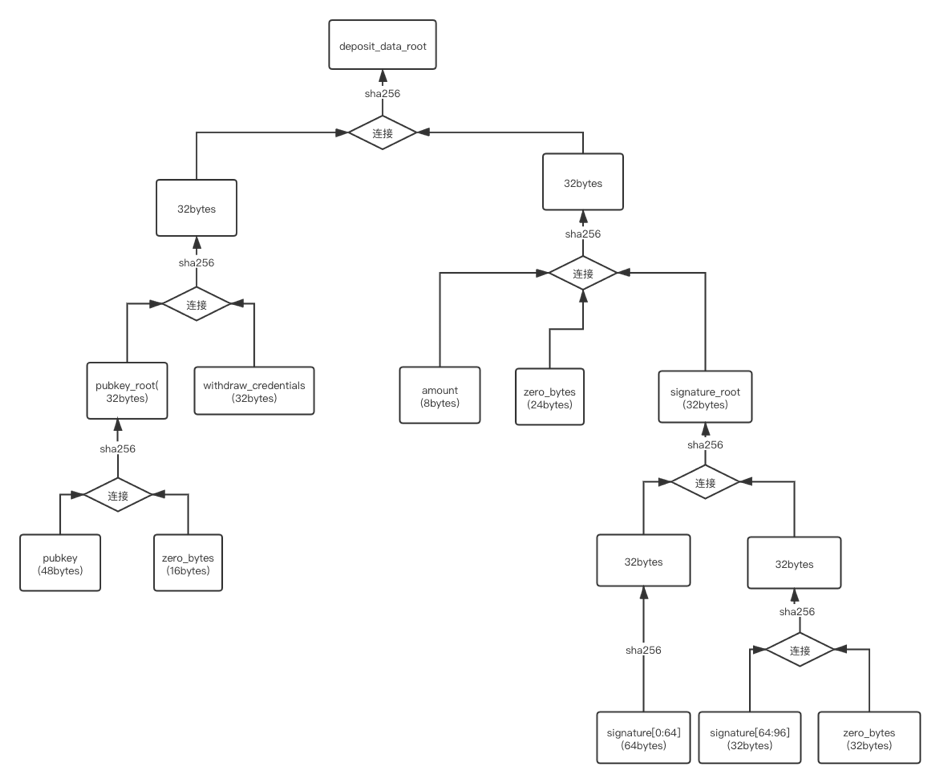

ETH2存款合约分析
source link: https://imnisen.github.io/eth2-deposit-contract.html
Go to the source link to view the article. You can view the picture content, updated content and better typesetting reading experience. If the link is broken, please click the button below to view the snapshot at that time.
ETH2存款合约分析
本文分析了以太坊2.0存款合约相关实现。
1 Deposit Contract
存款合约采用Vyper编写,合约地址: 存款合约 。
1.1 常量
合约先定义了一些常量,各个参数的长度等。
# Vyper target 0.1.0b13.hotfix1761 MIN_DEPOSIT_AMOUNT: constant(uint256) = 1000000000 # Gwei DEPOSIT_CONTRACT_TREE_DEPTH: constant(uint256) = 32 MAX_DEPOSIT_COUNT: constant(uint256) = 4294967295 # 2**DEPOSIT_CONTRACT_TREE_DEPTH - 1 PUBKEY_LENGTH: constant(uint256) = 48 # bytes WITHDRAWAL_CREDENTIALS_LENGTH: constant(uint256) = 32 # bytes SIGNATURE_LENGTH: constant(uint256) = 96 # bytes AMOUNT_LENGTH: constant(uint256) = 8 # bytes
1.2 存款事件
然后定义了一个存款事件。这个时间在下面的deposit方法里调用,当收到存款事件时触发。 Eth2的beacon chain通过此事件得知存款的发生,以此来更新验证者相关信息。
DepositEvent: event({
pubkey: bytes[48],
withdrawal_credentials: bytes[32],
amount: bytes[8],
signature: bytes[96],
index: bytes[8],
})
1.3 merkle tree structure
合约本身采用merkle tree存储所有的存款事件,在上面的常量设置里,合约最多接受 2^32 -1 个deposit。
最大的merkle tree深度为32。由于在智能合约里直接维护这样的结构比较费时费空间(需要gas)。
于是合约采用了incremental Merkle tree 算法。将计算Merkle Tree Root的时间和空间复杂度由 O(2^h) 减少到 O(h) .
合约里采用两个数组来实现:
branch: bytes32[DEPOSIT_CONTRACT_TREE_DEPTH]
deposit_count: uint256
# Compute hashes in empty sparse Merkle tree
zero_hashes: bytes32[DEPOSIT_CONTRACT_TREE_DEPTH]
@public
def __init__():
for i in range(DEPOSIT_CONTRACT_TREE_DEPTH - 1):
self.zero_hashes[i + 1] = sha256(concat(self.zero_hashes[i], self.zero_hashes[i]))
1.4 type convert
接下来定义了类型转化方法将uint256转化成bytes.
@private
@constant
def to_little_endian_64(value: uint256) -> bytes[8]:
# Reversing bytes using bitwise uint256 manipulations
# Note: array accesses of bytes[] are not currently supported in Vyper
# Note: this function is only called when `value < 2**64`
y: uint256 = 0
x: uint256 = value
for _ in range(8):
y = shift(y, 8)
y = y + bitwise_and(x, 255)
x = shift(x, -8)
return slice(convert(y, bytes32), start=24, len=8)
1.5 公共方法
接下来合约定义了三个公开的方法: get_deposit_root, get_deposit_count, 和 deposit 。
get_deposit_root 获取所有deposit的merkle root.
@public
@constant
def get_deposit_root() -> bytes32:
zero_bytes32: bytes32 = 0x0000000000000000000000000000000000000000000000000000000000000000
node: bytes32 = zero_bytes32
size: uint256 = self.deposit_count
for height in range(DEPOSIT_CONTRACT_TREE_DEPTH):
if bitwise_and(size, 1) == 1: # More gas efficient than `size % 2 == 1`
node = sha256(concat(self.branch[height], node))
else:
node = sha256(concat(node, self.zero_hashes[height]))
size /= 2
return sha256(concat(node, self.to_little_endian_64(self.deposit_count), slice(zero_bytes32, start=0, len=24)))
get_deposit_count 获取一共有多少deposit.
@public
@constant
def get_deposit_count() -> bytes[8]:
return self.to_little_endian_64(self.deposit_count)
deposit 是主要的存入方法,定义了当存款事件发生时如何处理。
@payable
@public
def deposit(pubkey: bytes[PUBKEY_LENGTH],
withdrawal_credentials: bytes[WITHDRAWAL_CREDENTIALS_LENGTH],
signature: bytes[SIGNATURE_LENGTH],
deposit_data_root: bytes32):
# Avoid overflowing the Merkle tree (and prevent edge case in computing `self.branch`)
assert self.deposit_count < MAX_DEPOSIT_COUNT
# Check deposit amount
deposit_amount: uint256 = msg.value / as_wei_value(1, "gwei")
assert deposit_amount >= MIN_DEPOSIT_AMOUNT
# Length checks for safety
assert len(pubkey) == PUBKEY_LENGTH
assert len(withdrawal_credentials) == WITHDRAWAL_CREDENTIALS_LENGTH
assert len(signature) == SIGNATURE_LENGTH
# Emit `DepositEvent` log
amount: bytes[8] = self.to_little_endian_64(deposit_amount)
log.DepositEvent(pubkey, withdrawal_credentials, amount, signature, self.to_little_endian_64(self.deposit_count))
# Compute deposit data root (`DepositData` hash tree root)
zero_bytes32: bytes32 = 0x0000000000000000000000000000000000000000000000000000000000000000
pubkey_root: bytes32 = sha256(concat(pubkey, slice(zero_bytes32, start=0, len=64 - PUBKEY_LENGTH)))
signature_root: bytes32 = sha256(concat(
sha256(slice(signature, start=0, len=64)),
sha256(concat(slice(signature, start=64, len=SIGNATURE_LENGTH - 64), zero_bytes32)),
))
node: bytes32 = sha256(concat(
sha256(concat(pubkey_root, withdrawal_credentials)),
sha256(concat(amount, slice(zero_bytes32, start=0, len=32 - AMOUNT_LENGTH), signature_root)),
))
# Verify computed and expected deposit data roots match
assert node == deposit_data_root
# Add deposit data root to Merkle tree (update a single `branch` node)
self.deposit_count += 1
size: uint256 = self.deposit_count
for height in range(DEPOSIT_CONTRACT_TREE_DEPTH):
if bitwise_and(size, 1) == 1: # More gas efficient than `size % 2 == 1`
self.branch[height] = node
break
node = sha256(concat(self.branch[height], node))
size /= 2
接下来我们来主要看下这里的存储merkle tree的结构和deposit方法的逻辑。
2 Deposit

Deposit方法先校验了数据的有效性,然后更新Merkle Tree结构。
Deposit里是如何验证接收的depositdataroot参数的?
这取决于这里的 deposit_data_root 是如何构造的?
根据规范, deposit_data_root 是 DepositData 的一个防止篡改的记号(例如Merkle root或者checksum)。
DepositData 的结构如下:
class DepositData(Container):
pubkey: BLSPubkey
withdrawal_credentials: Bytes32
amount: Gwei
signature: BLSSignature # Signing over DepositMessage
整体的计算流程图如下:

图上的hash采用的是sha256,而HashTreeRoot是一种对复杂/简单对象的求merkle root的方式。
2.1 HashTreeRoot
HashTreeRoot提供了将一个对象按一定格式构建默克尔树,然后求得树的默克尔根值的方法。
类似于比特币将一个区块的所有交易ID按序排列构建默克尔树,获得根值记录到区块头部, HashTreeRoot可以将一个对象(bit,bytes, vector,list,containers等等)的各个部分按序排列然后构建默克尔树,获得根值。
可以参见规范上是如何分成几种类型描述HashTreeRoot的算法的。
下图根据规范上的说明,以递归演算的方式,说明如何求得 DepositData 的root.

本质上求的一个对象的HashTreeRoot是将其各个部分按照一定的bytes大小padding,然后一层一层向上merklezie。
而合约上由于接收的对象是固定的,所以直接按照一定的格式一步一步组装计算HashTreeRoot。
代码如下:
# Compute deposit data root (`DepositData` hash tree root)
zero_bytes32: bytes32 = 0x0000000000000000000000000000000000000000000000000000000000000000
pubkey_root: bytes32 = sha256(concat(pubkey, slice(zero_bytes32, start=0, len=64 - PUBKEY_LENGTH)))
signature_root: bytes32 = sha256(concat(
sha256(slice(signature, start=0, len=64)),
sha256(concat(slice(signature, start=64, len=SIGNATURE_LENGTH - 64), zero_bytes32)),
))
node: bytes32 = sha256(concat(
sha256(concat(pubkey_root, withdrawal_credentials)),
sha256(concat(amount, slice(zero_bytes32, start=0, len=32 - AMOUNT_LENGTH), signature_root)),
))
# Verify computed and expected deposit data roots match
assert node == deposit_data_root
翻译成直观的流程图如下:

3 TODO incremental Merkle tree
Recommend
About Joyk
Aggregate valuable and interesting links.
Joyk means Joy of geeK